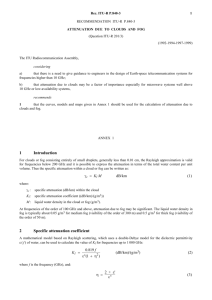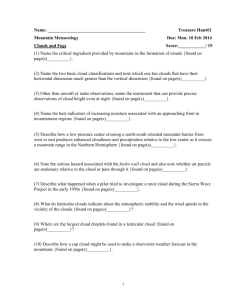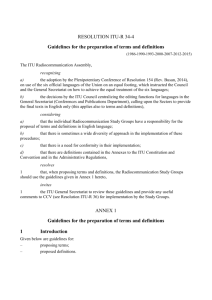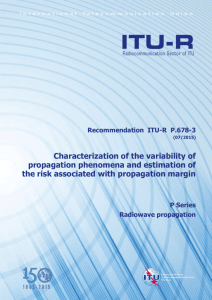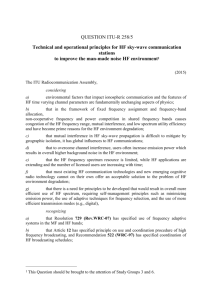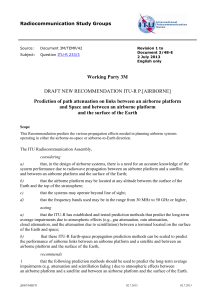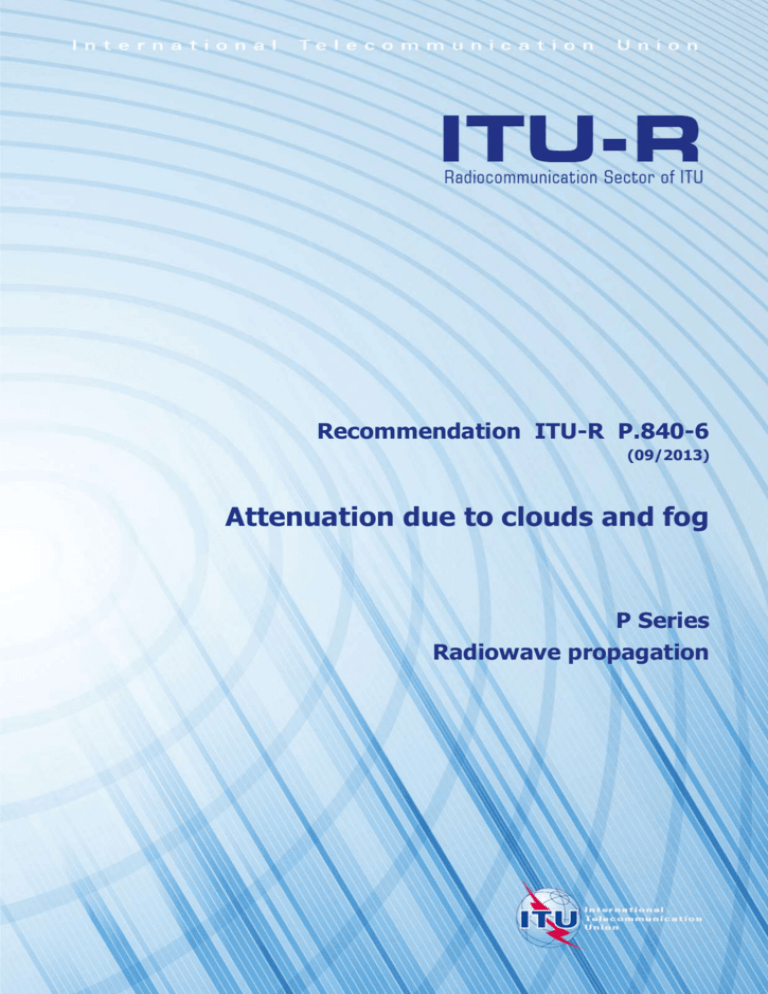
Recommendation ITU-R P.840-6
(09/2013)
Attenuation due to clouds and fog
P Series
Radiowave propagation
ii
Rec. ITU-R P.840-6
Foreword
The role of the Radiocommunication Sector is to ensure the rational, equitable, efficient and economical use of the
radio-frequency spectrum by all radiocommunication services, including satellite services, and carry out studies without
limit of frequency range on the basis of which Recommendations are adopted.
The regulatory and policy functions of the Radiocommunication Sector are performed by World and Regional
Radiocommunication Conferences and Radiocommunication Assemblies supported by Study Groups.
Policy on Intellectual Property Right (IPR)
ITU-R policy on IPR is described in the Common Patent Policy for ITU-T/ITU-R/ISO/IEC referenced in Annex 1 of
Resolution ITU-R 1. Forms to be used for the submission of patent statements and licensing declarations by patent
holders are available from http://www.itu.int/ITU-R/go/patents/en where the Guidelines for Implementation of the
Common Patent Policy for ITU-T/ITU-R/ISO/IEC and the ITU-R patent information database can also be found.
Series of ITU-R Recommendations
(Also available online at http://www.itu.int/publ/R-REC/en)
Series
BO
BR
BS
BT
F
M
P
RA
RS
S
SA
SF
SM
SNG
TF
V
Title
Satellite delivery
Recording for production, archival and play-out; film for television
Broadcasting service (sound)
Broadcasting service (television)
Fixed service
Mobile, radiodetermination, amateur and related satellite services
Radiowave propagation
Radio astronomy
Remote sensing systems
Fixed-satellite service
Space applications and meteorology
Frequency sharing and coordination between fixed-satellite and fixed service systems
Spectrum management
Satellite news gathering
Time signals and frequency standards emissions
Vocabulary and related subjects
Note: This ITU-R Recommendation was approved in English under the procedure detailed in Resolution ITU-R 1.
Electronic Publication
Geneva, 2013
ITU 2013
All rights reserved. No part of this publication may be reproduced, by any means whatsoever, without written permission of ITU.
Rec. ITU-R P.840-6
1
RECOMMENDATION ITU-R P.840-6
Attenuation due to clouds and fog
(Question ITU-R 201/3)
(1992-1994-1997-1999-2009-2012-2013)
Scope
This Recommendation provides methods to predict the attenuation due to clouds and fog on Earth-space
paths.
The ITU Radiocommunication Assembly,
considering
a)
that there is a need to give guidance to engineers in the design of Earth-space
telecommunication systems for frequencies higher than 10 GHz;
b)
that attenuation due to clouds may be a factor of importance especially for microwave
systems well above 10 GHz or low-availability systems;
c)
that for the calculation of the time series of total attenuation and space-time prediction
methods, an analytical expression for the statistics of the total columnar content of cloud liquid
water is needed,
recommends
1
that the curves, models and maps given in Annex 1 should be used for the calculation of
attenuation due to clouds and fog;
2
that the information in Annex 1 should be used for global calculations of propagation
effects, required by, inter alia, space-time channel models, that require an analytic expression for
the statistics of the total columnar content of cloud liquid water.
Annex 1
1
Introduction
For clouds or fog consisting entirely of small droplets, generally less than 0.01 cm, the Rayleigh
approximation is valid for frequencies below 200 GHz and it is possible to express the attenuation
in terms of the total water content per unit volume. Thus the specific attenuation within a cloud or
fog can be written as:
c Kl M
dB/km
where:
c :
specific attenuation (dB/km) within the cloud
Kl :
specific attenuation coefficient ((dB/km)/(g/m3))
M:
liquid water density in the cloud or fog (g/m3).
(1)
2
Rec. ITU-R P.840-6
At frequencies of the order of 100 GHz and above, attenuation due to fog may be significant. The
liquid water density in fog is typically about 0.05 g/m3 for medium fog (visibility of the order of
300 m) and 0.5 g/m3 for thick fog (visibility of the order of 50 m).
2
Specific attenuation coefficient
A mathematical model based on Rayleigh scattering, which uses a double-Debye model for the
dielectric permittivity ( f ) of water, can be used to calculate the value of Kl for frequencies up to
1 000 GHz:
Kl
0.819 f
" (1 2 )
(dB/km)/(g/m3)
(2)
where f is the frequency (GHz), and:
η
2 ε'
ε"
(3)
The complex dielectric permittivity of water is given by:
ε" ( f )
ε' ( f )
fp
f (ε 0 – ε1 )
f (ε1 – ε 2 )
2
1 ( f / fp)
f s 1 ( f / f s )2
ε 0 – ε1
1 ( f / f p )2
(4)
ε1 – ε 2
ε2
1 ( f / f s )2
(5)
where:
0 = 77.66 + 103.3 ( – 1)
(6)
1 = 0.0671ε0
(7)
2 = 3.52
(8)
= 300 / T
(9)
with T the temperature (K).
The principal and secondary relaxation frequencies are:
fp = 20.20 – 146 ( – 1) + 316 ( – 1)2
fs = 39.8fp
3
GHz
GHz
(10)
(11)
Cloud attenuation along slant paths
To obtain the attenuation due to clouds along slant paths for a given probability, the statistics of the
total columnar content of liquid water reduced to a temperature of 0°C, Lred (kg/m2 or, equivalently,
mm) for a given site must be known yielding:
A
Lred K l
sin θ
dB
for 90° 5°
(12)
Rec. ITU-R P.840-6
3
where is the elevation angle and Kl is calculated from equations (2) to (11) for a water
temperature of 0°C.
The annual values of total columnar content of reduced cloud liquid water, Lred (kg/m2), exceeded
for 0.1, 0.2, 0.3, 0.5, 1, 2, 3, 5, 10, 20, 30, 50, 60, 70, 80, 90, 95 and 99% of an average year are an
integral part of this Recommendation and are available in the form of digital maps.
The monthly values of total columnar content of reduced cloud liquid water, Lred (kg/m2), exceeded
for 1, 2, 3, 5, 10, 20, 30, 50, 60, 70, 80, 90, 95 and 99% of each average month are an integral part
of this Recommendation and are available in the form of digital maps. The annual and monthly
values of total columnar content are provided in the file R-REC-P.840-6-201309-I!!ZIP-E.
The data is from 0° to 360° in longitude and from +90° to –90° in latitude, with a resolution of
1.125º in both latitude and longitude. The total columnar content of reduced cloud liquid water at
any desired location on the surface of the Earth can be derived by the following interpolation
method:
a)
determine the two probabilities, pabove and pbelow, above and below the desired probability,
p, from the set: 0.1, 0.2, 0.3, 0.5, 1, 2, 3, 5, 10, 20, 30, 50, 60, 70, 80, 90, 95 and 99% for
annual statistics and from the set: 1, 2, 3, 5, 10, 20, 30, 50, 60, 70, 80, 90, 95 and 99% for
monthly statistics;
b)
for the two probabilities, pabove and pbelow, determine the total columnar content of reduced
cloud liquid water, Lred1, Lred2, Lred3, and Lred4 at the four closest grid points;
c)
determine the total columnar content of reduced cloud liquid water, Lredabove and Lredbelow, at
the probabilities, pabove and pbelow, by performing a bi-linear interpolation of the four values
of total columnar content of reduced cloud liquid water, Lred1, Lred2, Lred3, and Lred4 at the
four grid points, as described in Recommendation ITU-R P.1144;
d)
determine the total columnar content of reduced cloud liquid water, Lred, at the desired
probability, p, by interpolating Lredabove and Lredbelow vs. pabove and pbelow to p on a linear Lred
vs. log p scale.
3.1
Approximation of Lred by a log-normal distribution
The annual statistics of the total columnar content of reduced cloud liquid water content can be
approximated by a log-normal distribution. The mean, m, standard deviation, , and probability of
reduced liquid water, Pclw, parameters of the log-normal distribution are an integral part of this
Recommendation in the form of digital maps.
The total columnar content of reduced cloud liquid water at any desired location on the surface of
the Earth can be derived by the following interpolation method:
a)
b)
determine the parameters, m1, m2, m3, m4, 1, 2, 3, 4, PCLW1, PCLW2, PCLW3 and PCLW4 at the
four closest grid points;
determine the total columnar content of reduced cloud liquid water Lred1, Lred2, Lred3, and
Lred4 for the desired probability, p, at the four closest grid points from the parameters m1,
m2, m3, m4, 1, 2, 3, 4, PCLW1, PCLW2, PCLW3 and PCLW4 as follows:
Lred ,i
P
mi σ i Q 1
PCLW i
e
for i = 1, 2, 3, 4
(13)
4
Rec. ITU-R P.840-6
where:
1
Q x
2π
c)
e
t2
2 dt
(14)
x
determine the total columnar content of reduced cloud liquid water at the desired location
by performing a bi-linear interpolation of the four values of total columnar content of
reduced cloud liquid water, Lred1, Lred2, Lred3, and Lred4 at the four grid points as described in
Recommendation ITU-R P.1144.

